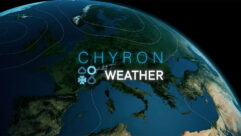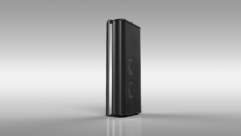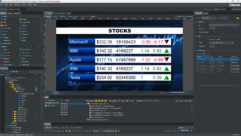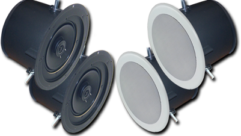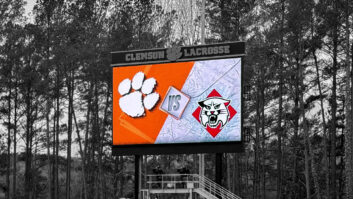Under the weather
Jan 1, 2000 12:00 PM,
Peter Mapp
Effective systems design for outdoor sound transmission requires an acuteawareness of the many variables that will affect sound quality.
Designing and operating sound systems for outdoor locations and events isone of the more nerve-racking aspects of our industry. Like so many thingsin life, when you get it right, and everything is going in your favor, itcan be an incredibly rewarding experience to provide coverage for a hugeoutdoor event or facility. Get it just a little bit off perfect, however,and have things go against you, and you can end up with problems of a moretitanic nature with that awful accompanying sinking feeling. This is oftenput into perspective by audience members or the facility owner with remarksalong the lines of “We can fly a man to the moon and send back live colorTV pictures, but try to get sound 100 feet….”
In simple terms, the problem can probably be divided into the followingthree categories – not getting the sound where you wanted it, getting thesound where you did not want it, and getting the sound where you wanted it,but for some unaccountable reason, not sounding how you wanted it. There isalso a fourth category that can be added to any of the above, which isgetting sound where the neighbors or city authorities did not want it.
It can come as a shock to discover that the point-and-shoot approach thatyou have successfully applied for years to indoor systems may not workout-of-doors. All of a sudden, the useful “straight line, like light”analogy that we all know does not work. So, what is going on? Well, you canblame it on the weather.
With outdoor sound systems, not only are there different acoustic issues todesign for and overcome, but there are more demanding physical andmechanical conditions. There are many immediate acoustic problems. Withspherical divergence (spreading), the inverse square law rules, and thereis no reverberant field to help fill in the coverage cracks or sweeten thesound. Temperature and humidity change the received frequency response,speed of sound and linearity of propagation. Ground plane impedance effectscan lead to frequency-selective attenuation of the sound. Wind directionand gradients can lead to sound hopping and formation of shadow zones.Local temperature fluctuations can create local velocity changes andphasing or time-alignment effects. With long path reflections, the lack ofa reverberant or a defined reflected sound field can again lead to longpath reflections from local buildings, walls and similar structures,thereby becoming audible.
Moreover, do not forget Murphy’s Law, for which there are severalvariations and additions to the normal indoor rules. Anything that can gowrong will go wrong, and there are plenty of examples. The wind has neverblown from that direction before. It never rains at this time of year.Hurricanes never occur in this area. It never snows here in July. We havenever had a flood here before. The neighbors never objected before. Thatbuilding never reflected sound before it was painted. The mains voltagenever did that before. The buffalo never migrate at this time of year. Oneother thing to remember about Murphy is that he was an optimist.
Proofing the system
Before tackling those acoustic issues, however, let us consider some of thephysical, and environmental equipment problems. With outdoor systems,especially permanent installs, the weatherproofing of the devices andequipment is an obvious additional requirement, and there are manywell-known, tried-and-tested treatments and materials. These range from theuse of epoxy resin coats, use of special timber for cabinet construction orthe use of fiberglass. Drivers can be screened and specially doped orinherently water resistive materials employed. The temperature range overwhich equipment has to operate, however, must also not be neglected,particularly if subjected to direct sunlight or operated in freezingconditions. The effect on the whole system must be thought through. Forexample, the loudspeaker drivers and cones themselves may be fine, but willthe ferrofluid still be within its operating range? Equally, in many urbanareas, air pollution can cause accelerated corrosion or rusting as can theatmosphere in coastal regions. The effects of general humidity andcondensation also need to be considered. Sometimes, just leaving the systemswitched on and running can overcome certain temperature and condensationproblems. Equally, injecting either an ultrasonic or low-frequency(subsonic) line surveillance tone into the system may be enough to keepdrivers and cones from freezing.
Outdoor acoustics
Because there will be no reverberant field, it is reasonable to assume thatthe sound level falls off with increasing distance as per the inversesquare law. (6 dB decrease for every doubling of distance). In practice,however, this may not be the case. Among the potential reasons for this arehigh-frequency selective atmospheric attenuation effects,frequency-selective ground attenuation effects, local reflection effects,size of source, the effects of temperature gradients and temperatureinversions, and the effects of wind gradients. Before dealing with theclimatic considerations, let us sort out the other simpler factors.
Local reflection effects are reasonably obvious. Any large, flat,non-porous or, worse still, concave surface can potentially act as a soundreflector. It is also surprising how reflective trees can be, particularlywhen grouped together as in a wood or copse, even with spaces between them.Disturbing long path echoes can often be heard back from the edge ofwoodland as many outdoor concert promoters know to their cost. Figure 1shows the expected degree of disturbance for long path reflections as afunction of delay time and level. The ground can also act as a reflector.Depending upon its nature, it can also be a significant absorber,increasing the apparent attenuation with distance expected. For example, anadditional 5 dB to 6 dB may occur when transmitting sound over grass and 6dB to 10 dB over cultivated ground. The exact degree of attenuation willdepend upon the nature of the ground and height of the source and receiver.Figure 2, for example, shows a set of typical excess attenuation curves forsource and receiver heights of 6.5 feet and 5.25 feet (2 m and 1.6 m),respectively. The figure shows the excess attenuation to be highlyfrequency-dependent, being a maximum at around 400 Hz. Interestingly, itcan also be seen, however, that at distances up to 200 m (600 feet), gainsin levels of 4 dB to 5 dB can occur at around 1 kHz to 2 kHz.
The effective size of the source is also an important factor whendetermining the sound attenuation with distance. For example, a stadiumwith a distributed loudspeaker system, although containing a number ofindividual sources, will effectively act as one large source when viewedfrom a distance and will not act as a point source until several dimensionsaway. Equally, large arrays of loudspeakers will not act as point sourcesuntil at least a third of the longest dimension away, and then, they willexhibit a frequency-dependent attenuation. Figure 3 helps explain this andshows some simple rules of thumb for line and planar sources. A usefulpoint to remember and one that many neighbors understand all too well isthat the inverse square law still continues to operate once the sound haspassed the last listener or arena/stadium perimeter. For example, the newstadium sound system may well be able to produce 100 dBA 500 feet (152 m)away at the furthest seats, but at 1,000 feet (305 m) away, the level mayonly have dropped to 94 dBA and at 2,000 feet (610 m), it will be 88 dBA.At a mile away (assuming reasonable line of sight), the level will haveonly dropped to 80 dBA. This could be a distinct environmental problem! Theoverall balance of the received sound, however, would change. Thehigh-frequency levels would be selectively attenuated because of the airattenuation effects discussed below, but the low and mid frequencies woulddecrease only in accordance with the inverse square law.
High-frequency excess air attenuation
When transmitting sound over large distances (greater than 100 feet or 30m), a noticeable decrease in the high-frequency region can often be heardin addition to the normal inverse square losses. The attenuation is highlyfrequency dependent. For example, at 1 kHz the additional loss may bearound only 5 dB per kilometer (approximately 3,000 feet), whereas at 10kHz, the excess attenuation would be 100 dB. Figure 4 shows a typicalfamily of curves. The excess attenuation is highly dependent upon thehumidity with maximum attenuation occurring at low humidity. In fact, themaximum attenuation occurs at around 15% to 20% relative humidity as shownin Figure 5. Not only is the effect highly frequency dependent, but it alsodepends upon the temperature as shown in Figure 6, with maximum attenuationoccurring at around 68 degrees F (20 degrees C). The underlying process isquite complex with contributions being made to its understanding by suchnotable scientists as Lorentz, Rayleigh, Boltzman, Einstein and Henry, notto mention Newton and Waterson. The process, however, was not fullyunderstood until 1933 when Knudsen produced the definitive explanation,which showed that the attenuation is due to relaxational effects in thevibrational behavior of the oxygen molecule. (Binary collisions occurbetween oxygen and water vapor molecules, which are particularly effectivein transferring vibrational energy because of the near resonance betweenthe vibrational energy of the Hsubscript2O molecule and the bending mode ofthe Hsubscript2O molecule).
The frequency losses can be compensated for by means of standard filtertopologies, assuming that the loudspeakers can actually take the additionalpower required. A subjective and artistic aspect also has to be considered,which is that in normal life, we are subconsciously used to hearing reducedhigh-frequency sound content over long distances, and putting it back iscounter to expected experience. A careful balance, therefore, has to bestruck between maintaining speech and music clarity and natural-soundingreinforcement and reproduction.
Other effects of temperature and humidity
As we saw above, the excess high-frequency losses are dependent upontemperature and humidity. So, too, is the velocity of sound. The simpleequations
V = 20.06 square root of 273 + degree C
where V is meters, and degree C is the temperature in degree Celsius, or
V = 49 square root of 459.4 + degree F
where V is in feet, and F is the temperature in degree Fahrenheit, showthat the velocity of sound is proportional to the square root of thetemperature. To put this in perspective, a change of 1 degrees C causes achange of 0.6 m/s in velocity, or a 10 degrees C difference will cause a1.8% change in velocity. The relative humidity also affects the velocity ofsound. (The density of water vapor is around 40% less than that of air;therefore, a change in velocity proportional to the percentage of watervapor molecules present will occur). To put this into context, at 14 %relative humidity and 20 degrees C , the velocity is 0.2 m/s slower than indry air, while at 100% relative humidity, the velocity is 1.1 m/s fasterthan in dry air.
Now, what does this mean in practice? As the temperature and relativehumidity change throughout the day, so do the velocity of sound and thehigh-frequency attenuation effects. Relative humidity can typically changeby around 30% throughout the day and temperatures by 5 degrees C to 10degrees C or even 15 degrees C. Therefore, velocity changes of 6 m/s to 9m/s are quite common. The need to adjust tightly set signal alignment delaylines can consequently be put into perspective. For example, take a delaytower set exactly 328 feet (100 m) from the stage loudspeaker stacks. Atemperature change of 15 degrees C (for example, from 15 degrees C to 30degrees C or vice versa) results in a variation of 7.3 ms. Apart from thefairly slow, general temperature change that occurs between morning andevening periods, the local temperature at any point in the day is alsocontinually changing on a short-term, dynamic basis with typical variationsof 5 degrees C being common and 10 degrees C not being unusual. This cancause local heterogenous conditions in the air, leading to noticeablechanges in sound quality and balance at a receiver position. Phase changesto the signal will also occur.
Temperature gradients and inversion
Another effect of temperature on sound propagation is refraction. This canhave a significant effect on sound transmission. Refraction can be definedas the change in direction experienced by a sound as it passes obliquelyfrom one medium to another with a different speed. With temperature,refraction effects are complex and extremely difficult to predict withaccuracy. The temperature near the ground (up to a height of about 150 feetor 46 m for our discussion) varies with the time of day, time of year andheight. It also varies depending upon whether it is a bright or overcastday. The temperature gradient is the crux of the matter. Temperaturegradients are greatest near the ground. A negative temperature gradient ortemperature lapse usually exists during the day because warm air generallystays close to the ground with colder air above. A positive gradient ortemperature inversion usually exists at night. (See Figure 7.) When thetemperature of the air is higher near the ground than it is in the upper air, which is the usual daytime case, sound in the upper air will travelslower than at ground level, and the sound waves are bent upwards,resulting in quieter conditions at ground level. (See Figure 8.)Conversely, when the temperature is lower near the ground, which is theusual nighttime condition, the sound will travel faster in the upper airthan at ground level and be bent towards the ground, resulting inlong-range transmission.
This happens because dry air is relatively transparent to radiation fromthe sun, but during the day, the energy from this radiation heats theground. By means of conduction, the air in contact with the ground isheated, and being hotter than the air just above the ground, it rises. Theheat, which is absorbed by the air in contact with the ground, is carriedupward by convection. For this reason, a negative temperature gradient orlapse that may be larger near the ground exists during daytime hours. (SeeFigure 7a.) As the sun sets, the surface of the ground cools. This coolsthe air in contact with the ground, and a positive temperature gradient orinversion results. At greater heights, the temperature lapse still exists.(See Figure 7b.) The height of the inversion layer near the ground rises asmore of the lower level air is cooled. (See Figure 7c.) Bright sunny daysproduce larger temperature gradients and overcast days smaller gradients.Another common situation occurs when the sun heats the ground in themorning, resulting in a temperature lapse. Then, during either the latemorning or early afternoon, it becomes overcast, causing the ground tocool. This results in an inversion layer forming near the ground. Later,the overcast condition disappears, resulting in another temperature lapseto form near the ground. The overall effect of this process is an inversionlayer with a normal lapse above and below it as shown in Figure 7d. In theabsence of a wind gradient, this can cause the channeling of sound to occurover very long distances with little attenuation. Figures 8 and 9 show theeffect of a normal temperature lapse (negative temperature gradient) and aninversion (positive temperature gradient). From the above discussion, itshould be apparent how changes in temperature can significantly affectsound transmission as well as the resulting sound balance and quality atthe listener’s position.
Wind gradients
Some meteorological phenomena that affect sound propagation are windgradients. Unlike temperature gradients that affect sound propagationequally all around the source, wind gradients have different effects upwindand downwind. Under normal atmospheric conditions, the wind velocityincreases with height above the ground. The effect on sound transmissioncan be seen in Figure 10. Here, the different effects upwind and downwindof the source are seen with a shadow zone being formed upwind and a soundconcentration downwind. Wind effects usually have a greater influence onsound propagation than temperature, but ironically, it is the temperaturegradient that fundamentally causes the wind in the first place. Forexample, wind gradients can cause increases of up to 5 dB over theanticipated normal propagation, but they can cause excess attenuationlosses of up to 20 dB. Temperature gradients, however, may typically causegains or losses of the order of 5 dB. In practical terms, there is littlethat an installer or operator can do to combat these effects, apart fromminimizing the distance the sound has to travel between the loudspeakersand audience. On the other hand, a basic knowledge of the underlyingconcepts can at least help to understand what is happening when the soundsuddenly disappears as the show is about to start.


